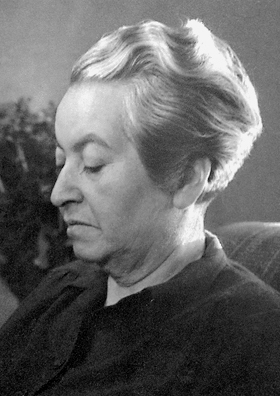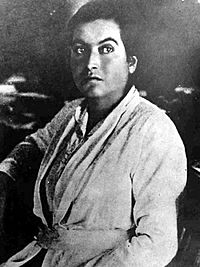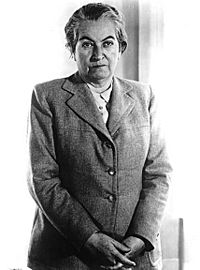Gabriela Mistral facts for kids
Quick facts for kids
Gabriela Mistral
|
|
|---|---|
 |
|
| Born | Lucila de María del Perpetuo Socorro Godoy Alcayaga 7 April 1889 Vicuña, Chile |
| Died | 10 January 1957 (aged 67) Hempstead, New York |
| Occupation | Educator, Diplomat, Poet. |
| Language | Spanish |
| Nationality | Chilean |
| Period | 1914–1957 |
| Notable awards | Nobel Prize in Literature 1945 |
| Signature | |
Lucila Godoy Alcayaga (born April 7, 1889 – died January 10, 1957) was a famous Chilean writer, teacher, and diplomat. She is better known by her pen name, Gabriela Mistral. In 1945, she made history by becoming the first Latin American author to win the Nobel Prize in Literature. The Nobel committee praised her "lyric poetry," which showed strong feelings and inspired people across Latin America.
Her poems often explored themes like nature, love, a mother's feelings, sadness, travel, and the unique identity of Latin America. This identity came from a mix of Native American and European cultures. You can even see her picture on Chile's 5,000 peso banknote!
Contents
Early Life and First Poems
Gabriela Mistral was born in Vicuña, Chile. She grew up in a small village called Montegrande in the Andes mountains. Her older sister, Emelina Molina, was a teacher and taught her at a primary school. Her father, Juan Gerónimo Godoy Villanueva, was also a schoolteacher. He left the family when Gabriela was very young.
Growing up, Gabriela's family was often poor. By the time she was fifteen, she was helping to support herself and her mother, Petronila Alcayaga. Her mother worked as a seamstress. Gabriela worked as a teacher's helper in a town near La Serena, Chile.
In 1904, Gabriela started publishing her early poems in local newspapers. She used different pen names, or fake names, to hide her identity. Some of her early poems were "Dreams" (Ensoñaciones) and "By the Sea" (Junto al Mar).
A sad event in her life deeply affected her writing. In 1906, she met Romelio Ureta, who later died in 1909. This sadness inspired her first famous literary work in 1914, called Sonnets on Death (Sonetos de la muerte). She won first prize in a national writing contest in Santiago, Chile. Writing about loss helped her explore bigger ideas about life and death in her poems. She chose the name Gabriela Mistral as her pen name. It came from two poets she admired, Gabriele D'Annunzio and Frédéric Mistral. Another story says it came from the Archangel Gabriel and the strong mistral wind.
In 1922, Gabriela Mistral published her first book, Desolation (Desolación). This book was a collection of poems about motherhood, religion, nature, and the love of children. Her personal sadness was clear in these poems. This book helped her become famous around the world. Two years later, in 1924, she released her second book, Tenderness (Ternura).
A Career as an Educator
When Gabriela was a teenager, Chile needed many teachers, especially in the countryside. Even without much formal schooling, she could find work as a teacher. She was not able to attend a special teacher training school in 1907. This was likely because of her writings that supported making education available to everyone.
Even though she stopped formal schooling by 1900, she became a teacher. Her older sister, Emelina, who was also a teacher's aide, helped her. Gabriela became a better-known teacher by publishing her writings in newspapers and magazines. She also moved often for new teaching jobs. Between 1906 and 1912, she taught in several towns across Chile. By 1912, she was teaching at a high school in Los Andes.
In 1918, Pedro Aguirre Cerda, who later became Chile's president, helped her become the director of the Sara Braun Lyceum in Punta Arenas. She then moved to Temuco in 1920, and Santiago in 1921. In Santiago, she became the director of the country's newest and most respected girls' school, Liceo #6.
In 1922, Gabriela Mistral accepted an invitation to work in Mexico. She helped Mexico's Minister of Education, José Vasconcelos, create a national education system. That same year, her book Desolación was published in New York. This brought her even more international fame. She also published Lecturas para Mujeres (Readings for Women). This book was a collection of writings that celebrated the education of girls.
After almost two years in Mexico, she traveled to Washington D.C. She spoke at the Pan American Union. Then she toured Europe. In Madrid, she published Ternura (Tenderness). This book was a collection of lullabies and songs for children. In early 1925, she returned to Chile and retired from teaching. The University of Chile had given her the special title of Spanish Professor in 1923. This was amazing because she had stopped formal schooling before she was 12 years old! She learned so much on her own by reading newspapers, magazines, and books.
The famous poet Pablo Neruda, who also won a Nobel Prize from Chile, met Gabriela Mistral when she moved to his hometown of Temuco. She read his poems and suggested books for him to read. They became friends for life.
International Work and Recognition
Gabriela Mistral's fame meant she was unlikely to stay in Chile. In 1925, she was asked to represent Latin America in a new group called the Institute for Intellectual Cooperation of the League of Nations. She moved to France in 1926 and lived outside Chile for the rest of her life. She earned money by writing for newspapers and giving lectures in the United States and Latin America. She visited many places, including the Caribbean, Brazil, Uruguay, and Argentina.
Between 1926 and 1932, Gabriela lived mainly in France and Italy. She worked for the League for Intellectual Cooperation. She attended meetings for women and educators across Europe and the Americas. She also taught as a visiting professor at Barnard College in New York in 1930–1931. She also taught briefly at Middlebury College and Vassar College in 1931. She was warmly welcomed at the University of Puerto Rico where she gave talks and wrote.
Like many Latin American artists, Gabriela Mistral worked as a consul for Chile from 1932 until her death. A consul is a diplomat who represents their country in another country. She worked in many cities, including Naples, Madrid, Lisbon, and New York City. As a consul in Madrid, she sometimes worked with Pablo Neruda, who was also a Chilean consul. She was one of the first writers to see how important and original his work was.
She wrote hundreds of articles for magazines and newspapers across the Spanish-speaking world. She was also a good speaker, both in person and on the radio. Many important people trusted her, including presidents of Colombia and Chile, and Eleanor Roosevelt.
Her second major book of poetry, Tala, came out in 1938. It was published in Buenos Aires with the help of her friend Victoria Ocampo. The money from selling the book went to children who had lost their parents in the Spanish Civil War. This book has many poems celebrating the traditions of Latin America and Europe. Gabriela Mistral blended these cultures in her work. She saw herself as having both European Basque and Indigenous American roots.
On August 14, 1943, Gabriela's 17-year-old nephew, Juan Miguel Godoy, passed away. Gabriela loved him like a son. The sadness from this loss, along with the tensions of World War II, can be seen in her last poetry book published during her lifetime, Lagar, in 1954. Another book of poems, Poema de Chile, was published after her death in 1967. Poema de Chile describes the poet's imagined return to Chile after death. She is joined by an Indian boy from the Atacama Desert and an Andes deer.

On November 15, 1945, Gabriela Mistral became the first Latin American person and the fifth woman to receive the Nobel Prize in Literature. She received the award in person from King Gustav of Sweden on December 10, 1945. In 1947, she received an honorary doctorate from Mills College in California. In 1951, she won the Chilean National Prize for Literature.
Poor health made it harder for Gabriela Mistral to travel in her later years. She lived in Roslyn, New York. In early January 1957, she moved to Hempstead, New York. She passed away there on January 10, 1957, at 67 years old, due to illness. Her body was returned to Chile nine days later. The Chilean government declared three days of national mourning. Hundreds of thousands of people came to honor her.
Some of Gabriela Mistral's most famous poems include "Little Feet of a Child" (Piececitos de Niño) and "The Teacher's Prayer" (La Oración de la Maestra). She also wrote and published about 800 essays in magazines and newspapers.
Characteristics of Her Work
Gabriela Mistral's writing often includes themes of sadness and hardship. These feelings came from her difficult childhood, which had poverty and a lack of affection at home. However, from her early days as a rural teacher, Gabriela Mistral showed great love for children. This love is clear throughout her writing.
Religion also played a role in her literature, as Catholicism was important in her life. Yet, she always showed a balanced view of religion. Her work often combines religious ideas with feelings of love and kindness. This makes her one of the most important Latin American writers of the twentieth century.
Death and Legacy
Gabriela Mistral passed away from illness in Hempstead, New York, on January 10, 1957, at the age of 67. Her passing led to national mourning in Chile.
During the 1970s and 1980s, her image was sometimes used by the military government in Chile. They presented her as a symbol of "following rules" and "social order." However, her writings and life continue to inspire many. Her work remains a powerful voice in Latin American literature.
Themes in Her Poetry
Gabriela Mistral has had a huge impact on Latin American poetry. A member of the Swedish Academy, Hjalmar Gullberg, explained her importance when she received the Nobel Prize. He spoke about how her words could "shake the world."
After experiencing the loss of her first love, Gabriela Mistral began to write poems filled with themes of death and sadness. Her collection of poems called Desolación (Despair) was very impactful. The poems in this book often express the deep pain of losing someone loved, like a child or a loved one.
But themes of death and sadness are not the only ones in her books. Other important themes are love and motherhood. Her love for children, especially those she taught, shines through. Her collection of songs and rhymes, Ternura (Tenderness), shows these feelings. Published in Madrid in 1924, this book was loved by thousands of Mexican children. Because of her dedication to children, she became known as the "poet of motherhood."
Having lived through two world wars and other conflicts, she wrote her third major collection, Tala (Harvesting). The poems in Tala mix sacred hymns with simple songs for children. They also talk about everyday things like water, corn, salt, and wine. Gullberg called Gabriela Mistral "the great singer of sorrow and motherhood for Latin America." Her wonderful poems and songs show her deep care for children and the sadness she experienced as a teacher and poet.
Awards and Honors
- 1914: Juegos Florales, Sonetos de la Muerte
- 1945: Nobel Prize in Literature
- 1951: Chilean National Prize for Literature
The Venezuelan writer and diplomat who used the name Lucila Palacios chose her pen name to honor Gabriela Mistral's original name.
Works
- 1914: Sonetos de la muerte ("Sonnets of Death")
- 1922: Desolación ("Despair")
- 1923: Lecturas para Mujeres ("Readings for Women")
- 1924: Ternura: canciones de niños ("Tenderness: Children's Songs")
- 1934: Nubes Blancas y Breve Descripción de Chile ("White Clouds and Brief Description of Chile")
- 1938: Tala ("Harvesting")
- 1941: Antología: Selección de Gabriela Mistral ("Anthology: Selection by Gabriela Mistral")
- 1952: Los sonetos de la muerte y otros poemas elegíacos ("The Sonnets of Death and Other Elegiac Poems")
- 1954: Lagar ("Wine Press")
- 1957: Recados: Contando a Chile ("Messages: Telling Chile")
- 1957: Croquis mexicanos; Gabriela Mistral en México ("Mexican Sketches; Gabriela Mistral in Mexico")
- 1958: Poesías completas ("Complete Poems")
- 1967: Poema de Chile ("Poem of Chile"), published after her death
- 1992: Lagar II, published after her death
Works Translated into Other Languages
English
Many of Gabriela Mistral's poems have been translated into English. Some translators include Doris Dana, Langston Hughes, and Ursula K. Le Guin.
Nepali
Some of her poems are translated into Nepali by Suman Pokhrel. They are in a book called Manpareka Kehi Kavita.
Bengali
A collection of her poetry and some prose was translated into Bengali in India in 2016. The book is called Banglay Gabriela Mistral.
See also
 In Spanish: Gabriela Mistral para niños
In Spanish: Gabriela Mistral para niños
- Barnard College, where some of Mistral's personal library is kept.
- Land of poets
- List of female Nobel laureates
Images for kids







